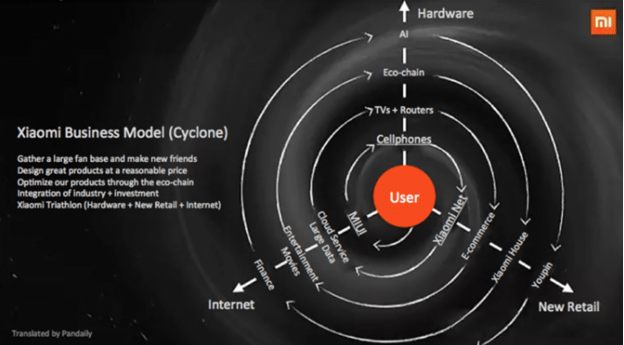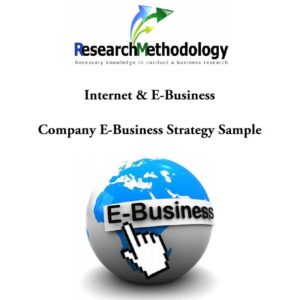Posts Tagged ‘internet’

Xiaomi business strategy can be classified as cost leadership. According to its founder and CEO Lei Jun, Xiaomi was founded on the belief that “high-quality technology doesn’t need to cost a fortune.”[1] Accordingly, the company offers smartphones and other internet-technology products and services for affordable prices. On a wider perspective, Xiaomi business strategy is based on the following four pillars: 1. Gathering and utilising a large fan base. Xiaomi has a large fan base involving millions of people across the globe. Fans spend countless hours online discussing Xiaomi products on various forums, thus increasing the level of brand awareness with no extra cost for the company. The mobile internet company enjoys cult-like following, the same way as its major competitor Apple. According to its business strategy, Xiaomi fosters, develops and encourages its fans via Mi Fan Festivals that involves discounts and gifts. The motto of the company is “Just for Fans” and the company is also known to recruit its new employees among Mi Fans. 2. Designing great products at a reasonable price. Xiaomi practices ‘design as you built’ philosophy, incorporating Mi Fans feedback in a constant manner at all stages of new product development. Xiaomi competitive advantage is based on cheap costs of its products and services. In simple terms, cheap costs of Xiaomi products and services is the main reason for consumers buying those products and services. 3. Constant optimization of products through eco-chain. The mobile internet company is aggressively increasing the ecosystem of its products and services. This is another important aspect of Xiaomi business strategy. Currently, Xiaomi ecosystem comprises 55 companies including 29 companies which were incubated from the ground up by Xiaomi.[2] The ecosystem produces ever-increasing range of products ranging from smartphones to rice cookers. 4. Xiaomi Triathlon: Hardware+New Retail+Internet. As it is illustrated in…

This report has been written for Managing Director of a business organisation and the report illustrates company e-business strategy sample. The report has been written because although the current website of the company has some e-commerce facilities its contribution to the level of revenues is significantly below from its full potential. The report discusses specific elements and issues of e-business strategy such as intranets and extranets, security and legal issues facing an online business organisation, and role of search engine in e-business strategy. Moreover, the report contains explanations of potential impact of a well-designed website on an e-business entity. The 21st century is being rightly classified as the age of information and Internet and innovations in information technology (IT) play increasingly great role in processional and even personal lives of many people. Moreover, internet offers unprecedented opportunities for business organizations. 1. Introduction 1 2. The role of intranets and extranets in business communication 1 3. Security and legal issues facing an online business organisation 2 4. Role of search engines in e-business strategy 3 5. Impact of well-designed website on an e-business 4 6. Conclusions 6 References 8 Amazon Bing Facebook Google Next Tesco Twitter Yahoo How do I receive the report? Once payment is made you will receive a link to you e-mail you have registered with on Pay Pal or the e-email you have entered when specifying bank details to download the report. The report is downloaded in PDF format. The link will stay active for 7 days. How can I use the report to complete my academic assignment/research? Reports and essays offered by research-methodology.net are professionally written samples in their respective areas. Reports and essays are intended to be used as guides and sources of secondary data for reference purposes. I did not receive the link/I can…

It is acknowledged by secondary data authors that online retailing in its various forms, including retailing of food and grocery products is considered to be a component of e-commerce. E-Commerce can be defined as “conducting business transactions – generally financial transactions – via communications technology” (Morley and Parker, 2010, p.431) Laudon and Traver (2009) inform that internet boom in general, and e-commerce in particular that has started towards the end of the last century had transformed the various aspects of lives of people significantly in a global scale. Authors offer different viewpoints about the nature of that affect but agree on the idea that “with the introduction of e-commerce, we have come to expect 24-hour delivery of products from across the world, and home delivery of groceries from the local Tesco at a time of our choosing” (Gustafsson, 2006, p.39) Hall (2008) mentions a survey conducted in 2008, which revealed that sixty-five percent of food companies were engaged in selling specialty food via internet. The following table illustrates the findings of the survey in a more detailed way: Internet Sales as Percent of Gross Sales Internet Sales as Percent of Total Sales in 2007 Internet Sales as Percent of Total Sales in 2008 Less than 10% 40.0 37.5 11-20% 10.0 10.0 21-30% 1.0 10.0 31-40% 2.0 2.5 41-50% 0.0 0.0 51-60% 2.5 0.0 More than 60% 2.5 2.5 No response 22.5 27.5 However, some authors (May, 2000, Kozami, 2002, Ashley, 2004, and others) dismiss the idea that purchasing food and grocery products through internet is an entirely new thing. They justify their stand by stating that “we should be suspicious of claims that internet provisioning is something entirely new. There are obvious continuities with existing telephone and television shopping, even if the service has become widespread and notionally democratized”…

To meet the high expectations of on-time delivery while keeping the delivery costs low, e-grocers need to use fairly advanced optimization techniques and information technology systems. With every grocery retailer there is a flow of finished goods from its suppliers, then from the company to its customers. Grocery retailers also exchange and receive information which provides valuable data for the system. These include feedback from the marketplace in the form of customers’ orders, customer reaction, and information on needs and wants; flows of information within the company that provide data in the form of inventory schedules, production schedules and so on as well as orders from the company to outside suppliers’. From a standpoint the whole company and the market in which it operates can be deemed as a series of linkages and relationships, and the efficiency in which the company operates can be seen to depend on how well these connections work. Having a system that works smoothly at minimum cost, would possibly allow for the company performance to be high. However this is not always the case in practice where it is common to find bottlenecks and poor integration between different parts of this system, leading to disappointing results. There are various methods and systems that can be implemented by retailers and over the past years the big supermarkets tried to adopt centralised models but where quick to abandon them in the past decade once they realised they would struggle with being efficient. This excludes Ocado which remains at the other end of the spectrum. ‘Ocado maintains that its centralised model will prove more efficient than the supermarkets’ store-picking approach once it achieves a critical mass’. The drawback is that Ocado might incur some difficulties if its tries to implement the hub and spoke system for the entire…

To be able to secure a customer, the need to understand the personal preferences and the decision making process of a customer is essential in addition to being able to link this to grocery e-shopping process. The concept then moves a step further with the company not just trying to market a product or service in store but convincing the customer that online shopping is not only available but is available as an option. This process allows the company to identify a unique selling point. Over the years grocery retailers have looked to create their individual selling points and incorporated a great deal of diversification to allow for some type of advantage. Tesco for example has responded and taken advantage of major changes in lifestyle patterns, and this is a key to its ongoing success. Tesco alone has generated more than two fifths of total sector sales capturing 12% of the sector. (Mintel 2009) In addition ‘Tesco as well as Asda have provided fantastic online offerings, making it easy for consumers to find and buy their groceries online,” said managing director of MyVoucherCodes.co.uk, Mark Pearson’. (http://www.utalkmarketing.com) Another contender in the retail market is Ocado which started trading in 2002 and is now one of Britain’s leading online grocers. As said in the afore-mentioned Ocado’s centralised system of distribution means it doesn’t need a network of stores to reach is customers. Ocado is the online grocery company that resells branded items, in addition to its own small range of own-brand goods and a wide selection of own-brand goods from the upmarket supermarket grocer, Waitrose. Ocado also has its green credential: Having its vans deliver the customers groceries generates less CO2 than walking to the local Tesco. It also collects and recycles customers’ unwanted plastic bags, sources biodiesel for fuel (vegetable fats…

E-Shopping SWOT Analysis Strengths A company’s ability to compete in its chosen industry highlights the level of success that it can achieve. Ocado is a clear example of how an organisation can create its own niche by specialising in a fraction of the actual industry therefore working against the usual business model of supermarkets. Although existing companies might already have an advantage with infrastructure a company’s strength will become evident if it is able to implement the e-commerce principle to expand its customer base whether it be on a local or global scale without expending too much time or capital that leads to its downfall. For an existing company, having a standard brick and mortar supermarket although deemed as an initial advantage, would not necessarily be the same for a new entrant. Having low overhead and start up costs for an e-shopping retail business would be more beneficial. These benefits though can extend to the consumer. Having an online business in this period is more of a necessity and consequently would allow a company better levels of communication which is achieved at every stage of the purchase especially through the use of e-mail. Weaknesses A customer in this market has no way of identifying the size of the company via the internet and consequently cannot identify the capabilities of the chosen company. Consequently a customer demands the same level of service from a new small online business as it would from a retail giant. A new company also has the task of identifying and understanding consumer behaviour, customer values and expectations therefore a new entrant is left with the task of designing and structuring a website that assists the consumer in locating the exact product that is desired as well as allows it to assert its position in a…

E-shopping commonly known as Electronic Commerce refers to the buying and selling of information, products and services via computer networks. (Kalakota and Whinston 1997) The global market for online grocery retailing remains at a relatively early stage of development in many parts of the world. To date, sales of food and drinks over the internet have yet to make the same impact observed in other parts of the consumer goods industry, most notably books, clothing and electronic items such as computer equipment. (www.companiesandmarkets.com) It has become clear that most of the existing retailers use the online service as an extension of the service that they provide in house. This allows them to provide another convenient element for the customer that might not be able to visit a store for the products that they require. Evidently retailers see their presence on the internet as an opportunity to further meet the needs of their customers employing the motto of ‘If you can’t come to us, we’ll come to you’. With most major supermarkets now competing online as well as offline, competition in the UK is intensifying to offer added value services to online customers, above and beyond the mere delivery of groceries (Robinson et al 2007). There is clear evidence to show that a lot of companies have tried to venture into this peculiar part of this industry and have subsequently failed. It remains clear that very little has been done to date to understand the evolution of consumers’ motivations, likes and dislikes when purchasing groceries online, as they become more experienced with this mode of shopping. (Robinson et al 2007). Meanwhile the sector remains dominated by store-based grocers such as the likes of Sainsbury’s, Tesco and Waitrose that have remained resilient in an ever changing and adapting industry and have enjoyed…
